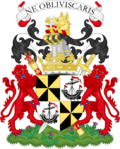Traditions: Difference between revisions
Vlaanderram (talk | contribs) |
Vlaanderram (talk | contribs) No edit summary |
||
| Line 37: | Line 37: | ||
== Scottish Tradition == |
== Scottish Tradition == |
||
<section begin="Scottish" />[ |
<section begin="Scottish" />[[Wikipedia:Scottish_heraldry| Scottish heraldry]] is the form of heraldic visual identity utilised in Scotland, as well as by its diaspora. It is distinct from tradition of the rest of the United Kingdom. |
||
[[File:Royal Coat of Arms of the Kingdom of Scotland.svg|thumb|400px|Royal coat of arms of Scotland]] |
[[File:Royal Coat of Arms of the Kingdom of Scotland.svg|thumb|400px|Royal coat of arms of Scotland]] |
||
[[File:Coat of Arms of the Lord Lyon King of Arms.svg|thumb|400px|Coat of arms of of the Lord Lyon King of Arms]] |
[[File:Coat of Arms of the Lord Lyon King of Arms.svg|thumb|400px|Coat of arms of of the Lord Lyon King of Arms]] |
||
Revision as of 07:47, 18 May 2022
American Tradition
As the use of coats of arms may be seen as a custom of royalty and nobility, it had been debated whether the use of arms is reconcilable with American republican traditions. Families from English, Scottish, Irish, Welsh, German, and other European nations with a heraldic tradition have retained their familial coat of arms in the United States. Several founding fathers also employed personal arms and a great number of Americans continue to do so.
Canadian Tradition
Derived mainly from heraldic traditions in France and the United Kingdom, Canadian heraldry also incorporates distinctly Canadian symbols, especially native flora and fauna, references to the First Nations, Inuit and other aboriginal peoples of Canada, and uniquely Canadian elements such as the Canadian pale, derived from the Canadian flag. A unique system of cadency is used for daughters inheriting arms, and a special symbol for United Empire Loyalists.
Iberian Tradition
Portuguese Heraldry and Spanish Heraldry are the two traditions that compose the Iberian Tradition, sharing key aspects and elements throughout history. Arms, other heraldic bearings and insignia used in the Portugal and Spain as in their colonial empires and historical territories.
Features
The main feature of this tradition is the use of the Iberian Shield (squared top and rounded bottom, also called "Peninsular", "Spanish" or "Portuguese") which appearance and use was most prevalent in Iberia. The use of a belt to attach the shield to the helm is also prominent, especially in In both countries.
Portuguese Heraldry is known for it's versatility in inheritance, armigers being able to equally inherit from the paternal and maternal line.
Both systems have a system of cadency, the Spanish one less used and the Portuguese one strictly applied.
The use of ordinaries like the bordure and the orle are a common trait. Words and letters and quartering as marshalling of arms are extremely used by both systems. Crests and helmets are also common in Spain and Portugal.
Lowlands Tradition
Dutch heraldry and Belgian heraldry is the form of coats of arms and other heraldic bearings and insignia used in the Kingdom of the Netherlands, the Kingdom of Belgium, the Grand Duchy of Luxembourg and the Dutch and Belgian colonial empire but also in the historical territories that make up the Lowlands (or Nederlands).
Features
The main feature of this tradition is the use of the barred helmet (often with a golden trim and a collar) and that for all individual they be from nobility or not. The use of a belt to attach the shield to the helm is also prominent, especially in Belgian heraldry. Traditionally, the torses of Nederlandse coat of arms also have five twists contrary to the six often seen in the british isles.
Belgian Heraldry is also known for blazoning not only the motto but the scroll, indicating the colours of the letters and of the scroll itself.
Both system do not have a system of cadency, all descendent of the armiger inherit his arms equally.
-
Coat of arms of Johannes Theodorus van Spengler and his descendant
-
Coat of arms of Kevin Haelterman van Spengler and his descendant
Authorities
-
Hoge Raad van Adel
High council of Nobility (Municipalities and Nobility)
-
Vlaamse Heraldische Raad
Flemish Heraldic Council (Flanders) -
Conseil d’Héraldique et de Vexillologie
Council of Heraldry and Vexillology (Wallonia and Region Brussel Capital)
Scottish Tradition
Scottish heraldry is the form of heraldic visual identity utilised in Scotland, as well as by its diaspora. It is distinct from tradition of the rest of the United Kingdom.
Features
The main feature of this tradition is the of mottos borne above the crest in achievements (with slogans or war cries placed beneath the escutcheon).
The Scottish tradition is characterised by a strict enforcement of cadency and differencing, as well as the uniqueness of each entity's armorial bearing.
The idea of a societal clan structure survives in the legal fiction that every individual bearing the same surname is related, and therefore new grants to petitioners may difference the senior arms of their name.
Heraldic compartments originate in Scotland, and are frequently used where supporters are borne.
While conventional heraldic badges are granted for individuals of certain statuses, all armigers are entitled to bear a Scottish crest badge, in which their crest is depicted surrounded by a circlet bearing their motto, with a varying quantity of eagle feathers behind. All those nominally 'following' the armiger may use a crest badge with no feathers, and the circlet replaced with a strap and buckle.
It is one of the few traditions actively regulated' in the present-day.
-
Coat of arms of Alexander Charles Richards Maitland
-
Coat of arms of the duke of Argyll
-
Crest Badge of the Clan Mac Donald


